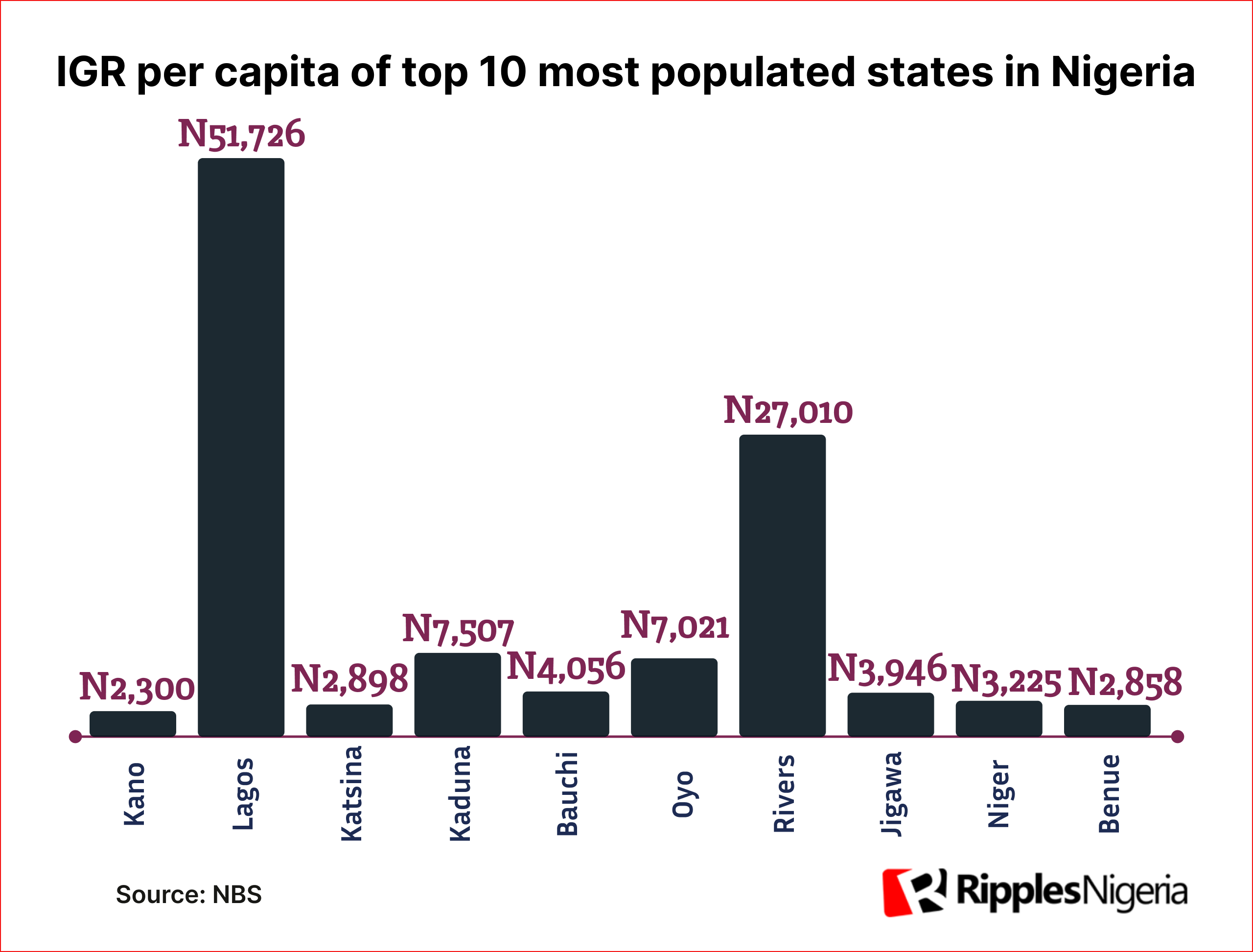Ripples Metrics
RipplesMetrics: Nigeria’s IGR per capita continues revenue decline

The latest report on Internally Generated Revenue (IGR) by the National Bureau of Statistics reveals new insights showing that states with larger populations in Nigeria are experiencing relatively low productivity in terms of revenue generation per capita.
This data reflects the income generated from taxes, service fees, and other government revenue sources, divided by the population size of each state. With a total population estimate of over 200 million people it shows a revenue generation or collection challenge in regions with higher population amidst rising economic uncertainty.
According to the report, only Lagos and Rivers states, which are among the most populous in Nigeria, ranked highest in revenue generation for 2023. Ripples Metrics had reported that Lagos, Rivers, and the Federal Capital Territory led in Internally Generated Revenue (IGR) for 2023, with figures of N815.86 billion, N211.10 billion and N195.41 billion respectively.
The three states pulled mroe than 50 per cent of the total N2.43 trillion generated as IGR in the 36 states.
Per capita drop across key states
Aside from Lagos and Rivers state, other states with the largest population in Nigeria are Kano, which is the highest, Kaduna, Katsina, Bauchi, Oyo, Jiawa, Niger and Benue. Our findings indicate that these 10 states account for approximately 40 per cent of Nigeria’s population, yet only two of them demonstrate higher revenue productivity
READ ALSO: RipplesMetrics: Only 9 states can fund personnel costs with IGR
The state with the largest population in Nigeria is Kano State with over 16 million people but this size compared to IGR generated in the state places the per capita at N2300 from each person. This is the second lowest IGR per capita when ranked over the 36 states.
Also, Kaduna and Katsina with a population of over nine and eight million respectively had a per capita of N2,898 and N7,507. Similarly, the per capita revenue for Bauchi, Oyo, Jiawa, Niger and Benue were N4,056, N7,021, N3,946, N3,225 and N2,858. Economic conditions, including rising unemployment and decreased business activity, have reduced the tax base and slowed IGR growth. Residents with lower incomes are contributing less in taxes, while businesses, already under pressure, are less able to pay fees and fines.
Further analysis by Ripples Metrics revealed that the FCT, Kwara, and Edo are among the states with smaller populations but higher internally generated revenue (iGR) per capita.
IGR lower in oil-producing states
A separate analysis of Nigeria’s nine oil-producing states revealed that a total of N556.93 billion was generated from these regions. The states involved include Ondo, Anambra, Rivers, Delta, Edo, Abia, Bayelsa, Akwa Ibom, and Imo.
However, the bulk of this revenue came from Delta and Rivers, which together accounted for N309.50 billion—over 55 per cent of the total. This highlights the significant role these states play in Nigeria’s oil-dependent economy, where oil production remains a key source of government revenue.
While the nine oil-producing states are integral to Nigeria’s oil economy, the significant share of revenue generated by Delta and Rivers states highlights the outsized role these regions play in the country’s overall financial structure, as well as the broader challenges Nigeria faces in managing its oil-dependent economy.
By: James Odunayo
Join the conversation
Support Ripples Nigeria, hold up solutions journalism
Balanced, fearless journalism driven by data comes at huge financial costs.
As a media platform, we hold leadership accountable and will not trade the right to press freedom and free speech for a piece of cake.
If you like what we do, and are ready to uphold solutions journalism, kindly donate to the Ripples Nigeria cause.
Your support would help to ensure that citizens and institutions continue to have free access to credible and reliable information for societal development.





























